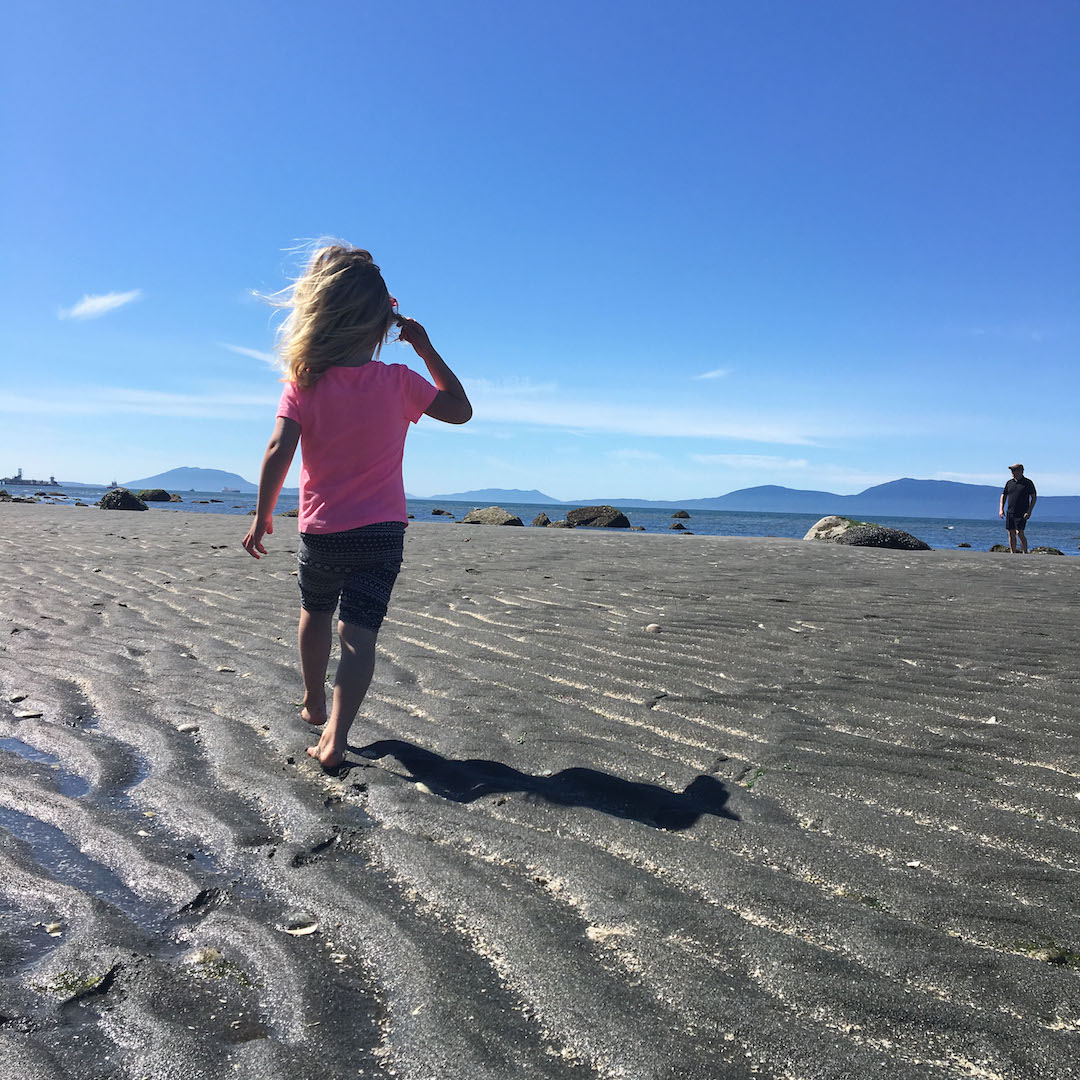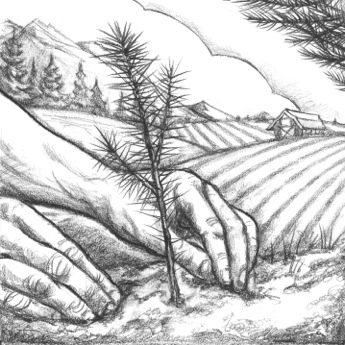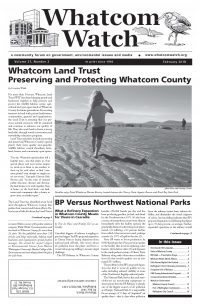by Lorraine Wilde
For more than 34 years, Whatcom Land Trust (WLT) has been bringing people and businesses together to help preserve and protect the wildlife habitat, scenic, agricultural and open space lands of Whatcom County for future generations. By securing interests in land with private landowners, communities, agencies and organizations, the Land Trust is ensuring that our precious natural resources will be sustained and continue to enhance our quality of life. They also work hard to foster a strong land ethic through sound conversation and stewardship education programs.
Land Trust priorities include protecting and preserving Whatcom County’s special places: their water quality and quantity, wildlife habitat, coastal shorelines, farmland, forests, and community open spaces. “For me, Whatcom’s special places tell a hopeful story—one that unites us. Your special places and your stories inspire us, invite us to listen to one another, to show up for each other, to find ‘common ground’ even though we might not see eye-to-eye,” Executive Director Rich Bowers said. “At this time of strained public discourse, distrust and division, the land invites us to work together. Here at home—at the local level—our land, stories and community offer a chance to grow closer, not farther apart.”
The Land Trust has identified seven focal areas throughout Whatcom County that guides their current and future efforts. Below is just a little bit about the Land Trust’s current holdings and their future priorities with more information about how you can get involved.
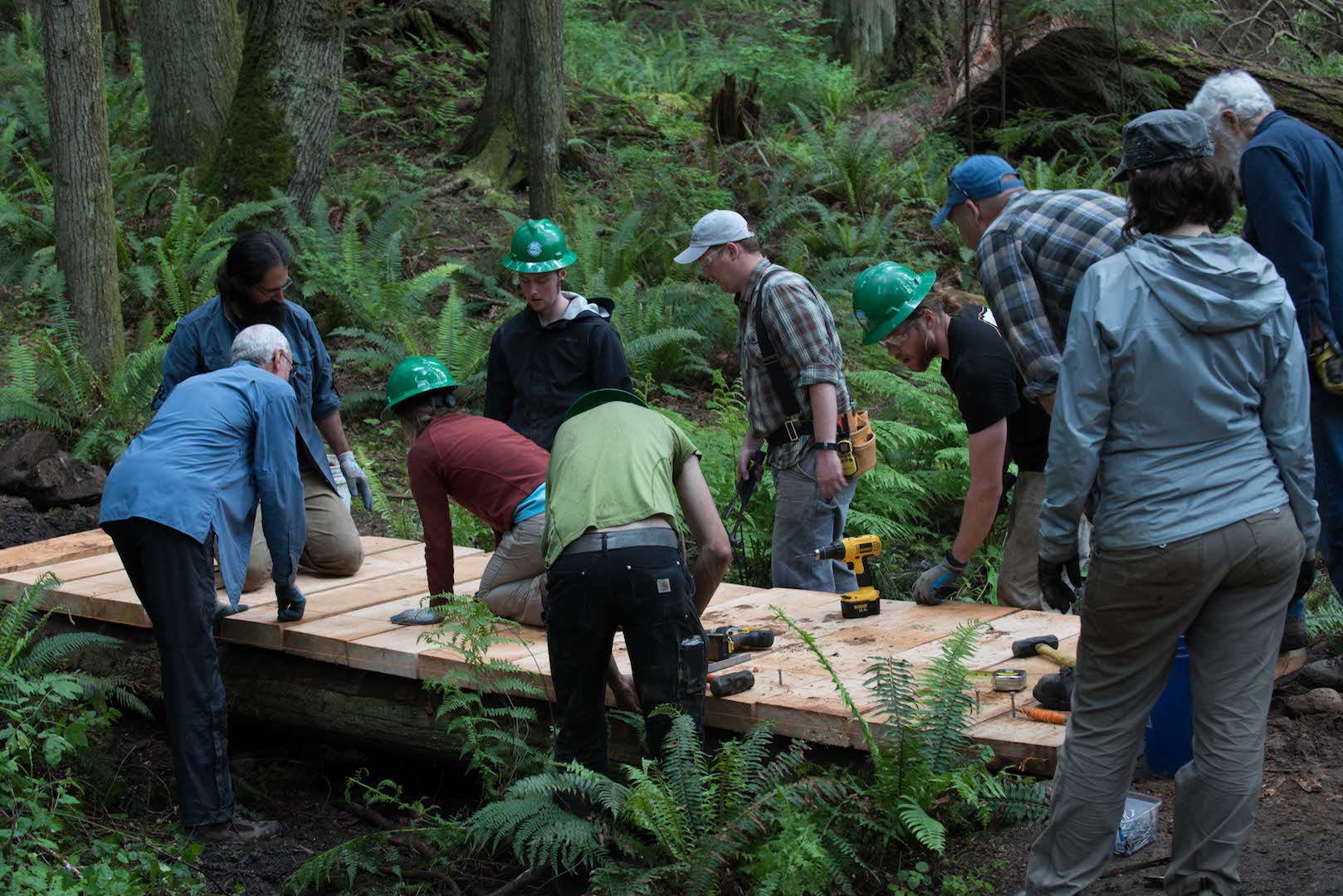
Whatcom Land Trust Staff, Volunteers and Volunteer Land Stewards improve trail conditions at Stimpson Family Nature Preserve. Photo courtesy Whatcom Land Trust.
Lake Whatcom Watershed
Lake Whatcom provides drinking water for more than 95,000 Bellingham residents. The water quality along its 7.6-mile length is at risk. Currently, the lake is listed by the Washington State Department of Ecology as an impaired water body for excessive phosphorus, and some of the streams entering the lake have been contaminated with fecal coliform bacteria. Excessive phosphorus supports growth of algae, depletes oxygen and poses a threat to the lake ecosystem. This can also impact drinking water quality and cost. Lake Whatcom could be further compromised by pollutants from storm water runoff, forestry practices and recreational uses. To protect and preserve this incredible resource, the Land Trust works with willing landowners to ensure a safe and adequate supply of drinking water for people, as well as quality waterways needed for healthy fisheries. They also conserve the natural features that provide critical habitat for native plants and animals. While some preserved properties are open for passive recreational use, most Land-Trust-preserved acreage is set aside as wildlife sanctuary.
Since 1990, WLT has secured almost 1,500 acres in the Lake Whatcom Watershed including Stimpson Family Nature Reserve, Lookout Mountain Preserve, Ladies of the Lake and the Lake Whatcom Reconveyance. These efforts limit development that could compromise water quality and quantity, wildlife habitat, and our local forests, shorelines and green spaces while continuing to provide the public with opportunities to enjoy the natural outdoors in more than 5,000 acres of parkland and 35 miles of trails.
But as the beauty and value of our area continues to attract new residents, more work will be needed to ensure the long-term protection of the watershed.
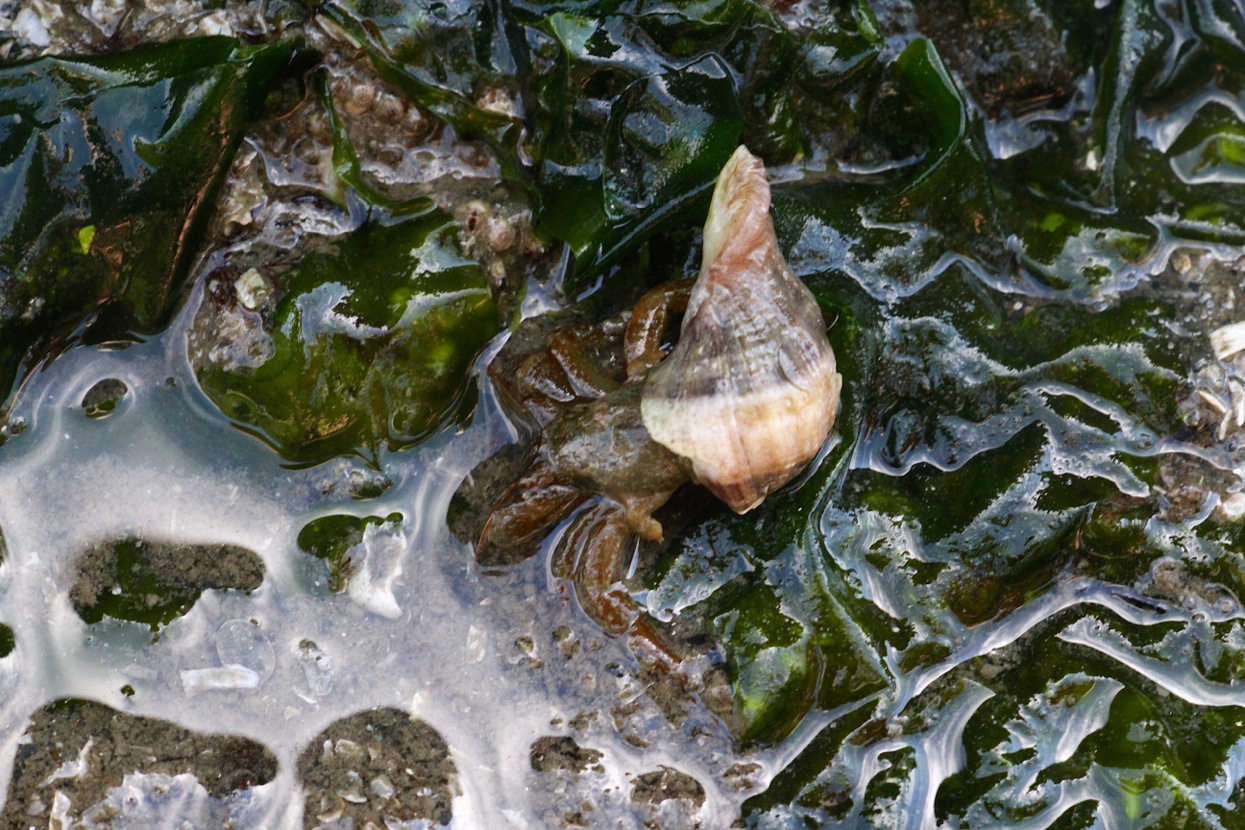
Whatcom Land Trust is protecting shoreline habitat and its adjacent forests and wetlands while balancing recreational uses. Photo by Alan Fritzberg.
Coastal Shorelines
Whatcom County has more than 134 miles of marine shoreline including river deltas and estuaries, to feeder bluffs, sandy beaches, and rocky shorelines. Each is unique, providing critical habitat and significant recreational value.
The Land Trust has already secured more than 32 miles of vital marine and freshwater shorelines from as far north as Eames Tidelands in Blaine’s Drayton Harbor, to ARCO and Terrell Creek Heron Colonies and Point Whitehorn Marine Reserve south of Birch Bay, to Plover Island and Smuggler’s Slough near Lummi Bay, on south to Madrona and Clark’s Points and Teddy Bear Cove. Each of these lands protect those essential habitats as well as the adjacent wetlands and forests.
As development pressure continues along our cherished shorelines, the Land Trust will work harder to protect, preserve and restore these critical areas.
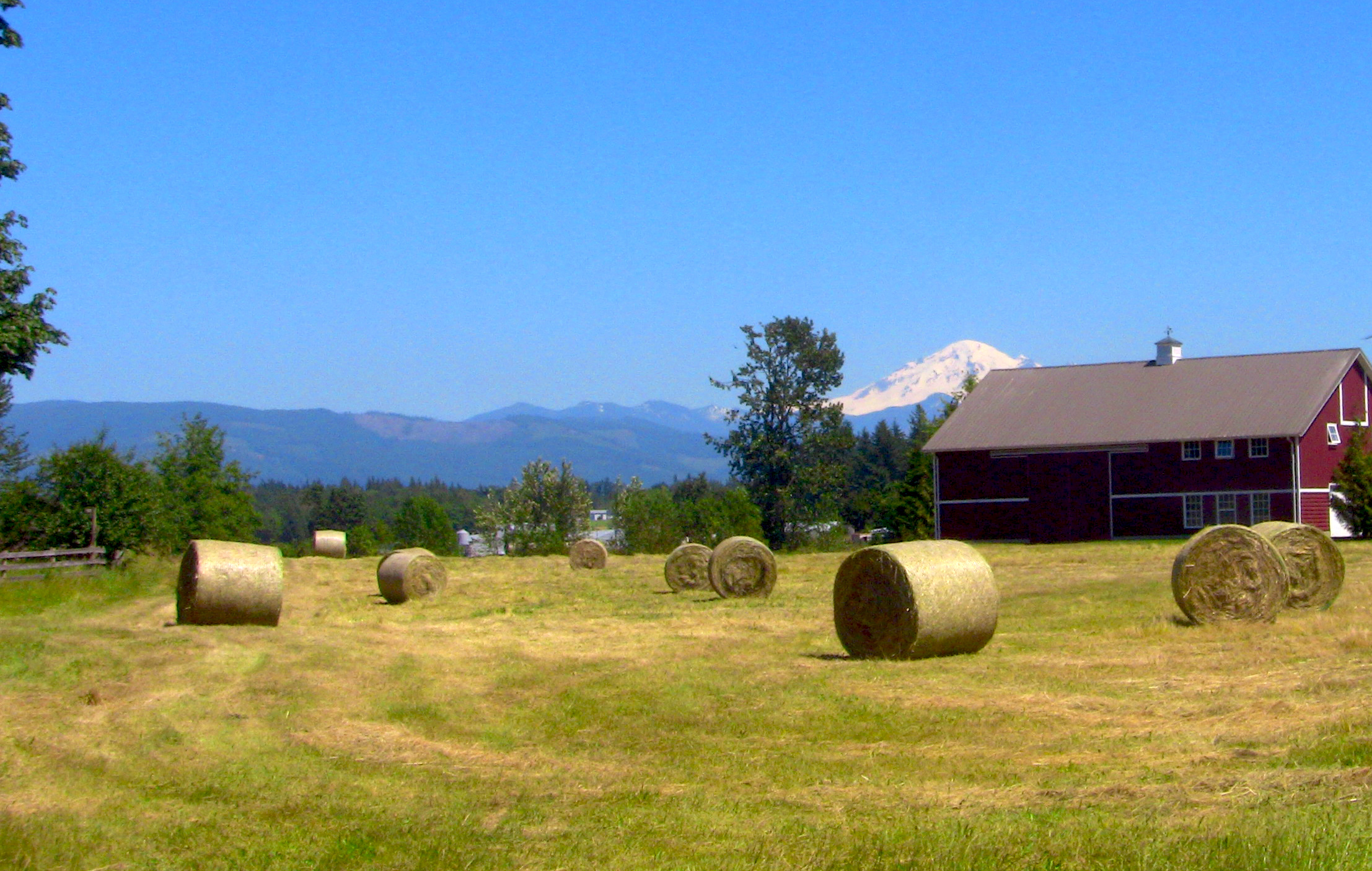
Whatcom County Farmers in the Core Agricultural Zone provide our community with food, water and timber products. Photo courtesy Whatcom Land Trust.
Whatcom Core Agricultural Zone
Whatcom County was built by the labor of its farmers and forest workers. The history of our farms and forest lands has influenced our vibrant local culture and continues to provide our communities with quality food, water and timber products.
Whatcom County has established a goal to maintain at least 100,000 acres to sustain a viable agricultural sector. In partnership with the county’s voluntary Purchase of Development Rights program, the Land Trust maintains agricultural conservation easements to permanently protect agricultural properties for local food and farmers.
More than 1,000 acres of agricultural, forestry and other working lands have been protected from development. These and future efforts will improve water quality and quantity, ensuring that the 85,000 acres of zoned agricultural land in our area remains sustainable.
Chuckanut Mountain
The rich habitat of the treasure that is Chuckanut Mountain includes mature second growth forests, wetlands, snags, cliffs, caves and wildlife corridors. Private working forests and public parks create recreational opportunities for local families and visitors from around the world. WLT focuses on protecting the existing high quality habitat and wildlife corridors of the area while working to limit residential development.
WLT efforts in securing the Great Whatcom Land Trade were the first step in protecting one of the last undeveloped areas where Whatcom and Skagit Counties meet, a 350,000-acre swath of prime forested wildlife habitat known as the Cascades-to-Chuckanuts Corridor. Connectivity of the Cascade Mountains to the Salish Sea at the foot of Chuckanut Mountain is critical for habitat protection, scenic preservation and the vitality of the region.
The Land Trust will continue to steward sustainable use of this area while striking a balance between private and public uses.
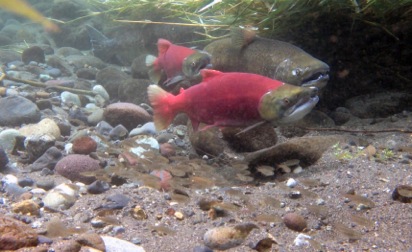
Whatcom Land Trust is reforesting stream and river corridors and restoring side channel habitat to protect future populations of salmon in the Nooksack, including this sockeye in Maple Creek Reach Preserve. Photo courtesy Whatcom Land Trust.
North and Middle Forks of the Nooksack River
The Nooksack River is home to several species of salmon that have been a pillar in the foundation of our community and ecosystem. But their future here is uncertain. In addition to protecting the water quality of the river, survival of future generations of the native fish will depend on protections and increases in side channel habitat for salmon spawning and rearing. This includes additional restoration of forested river corridors along tributary streams like Canyon Creek, Maple Creek and Clearwater Creek. Recovery efforts along more than 20 miles and more than 20 properties on the river — in addition to future acquisitions, easements, and partnerships — will ensure that degraded lands are rehabilitated and functional habitats for diverse species are reestablished.
Where streams have been diverted into uniform ditches, Land Trust staff and volunteers work to return natural meanders that promote reproductive success for fish and amphibians. With the help of multiple partners, WLT also replaces invasive weeds with native plants that provide food and shelter for mammals, birds and reptiles. Its acquisition of clear-cut tracts has already helped reestablish the natural forest and vegetation. These restored tracts create vital links between preserves, creating unbroken corridors where wildlife can thrive.
With support from conservation partners, grants and donations from county and city residents, the Land Trust coordinates more than 20 work parties each year with the help of hundreds of volunteers to accomplish these efforts. “Whatcom Land Trust is dependent on community support to carry out our mission,” Bowers said. “Much of our stewardship work involves habitat restoration and general upkeep on our many properties — planting trees, removing invasive plants and maintaining trails. We invite our community to volunteer at a work party, or make a long-term commitment by becoming a WLT Volunteer Land Steward.”
South Fork Nooksack River Valley
Commercial forestry and farming are the predominant land uses of this river valley that is dominated by forest, floodplains and wetlands. In addition to reforesting the river corridors, the Land Trust is working to limit development in the floodplains and improve water quality and quantity of the snow-fed South Fork where all five species of salmon can currently be found.
The Land Trust, along with representatives of five other organizations and local citizens, helped launch the South Fork Nooksack River Community Watershed Project. Facilitated by the Nooksack Tribe Natural Resources Department, a group of more than 45 residents and property owners met six times in 2017 to develop a framework for education and dialogue in the South Fork community and lay the foundation for future community watershed conservation planning efforts.
Upper South Fork Nooksack River
Just like the South Fork valley, the Upper South Fork contains major tributaries that are used as fisheries for the endangered Chinook salmon and the five species of Pacific salmon. This basin also supports elk and eagle habitats. By improving water quality through stewardship and restoring forested river corridor we can help the endangered salmon that have been a cornerstone of these ecosystems.
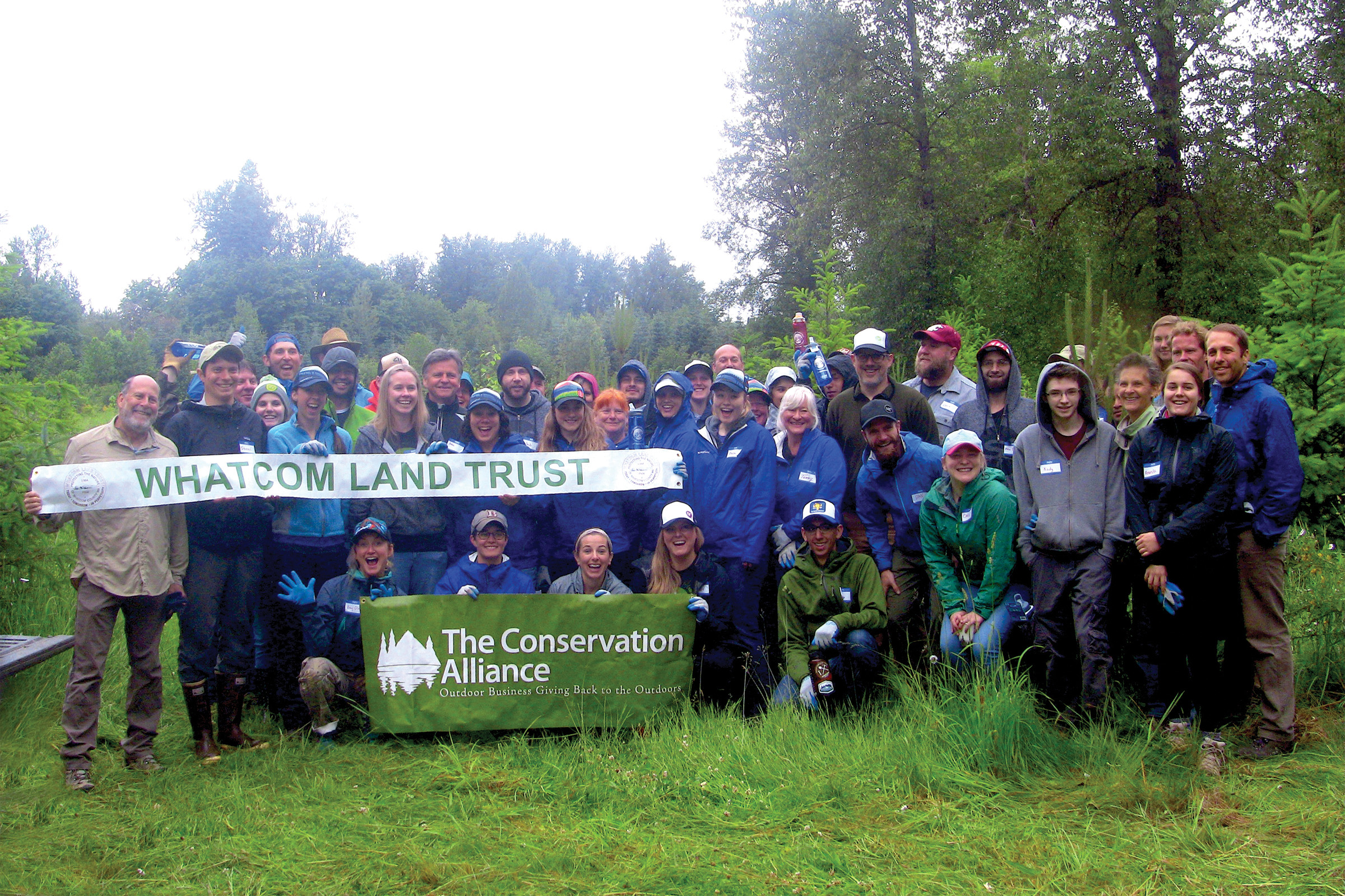
Whatcom Land Trust recently awarded the Ferndale-based Superfeet, shown here at the Backyard Collective at Maple Creek Reach Preserve, with the Bob Keller Business Conservation Leadership Award for their environmental stewardship. Photo courtesy of Whatcom Land Trust.
How to Get Involved
There are many ways to become a part of Land Trust team and further their mission to preserve and protect wildlife habitat, scenic, agricultural and open space lands of Whatcom County for future generations.
• Learn More — To stay up on Land Trust projects, check their website, sign up for their newsletter and follow them on Facebook and Instagram.
• Become a Volunteer — Work parties are held regularly and dates and locations are posted on the Stewardship page of the website and on Facebook.
• Become a Business Partner in Conservation — Businesses can support the work of WLT through a corporate grant, a range of business sponsorship levels, in-kind services or materials, ‘Adopt-a-Property’ or employee matching gift programs.
• Make a Donation — A variety of tax deductible donation options are available. One-time, monthly and annual donations may be made online via the website or through the mail, as well as memorial or honorary gifts. “It’s really about optimism and the future,” explains Philanthropy Director Jill Clark. “Gifts of appreciated stock or mutual funds, land gifting and planned gifts and beneficiary designation through your will, retirement plan, life insurance policy or bank account are all ways of preserving your legacy and leaning our shoulders and spirit into the good, hard work of land preservation for future generations of people, land and species. Community support will continue the work and the stories we begin today.” Contact Jill at 360-746-3423 with your donation questions.
The Land Trust team has been working tirelessly since 1984 with volunteers, landowners, communities, public agencies, organizations and concerned citizens to use creative — and sometimes complex — solutions to achieve their shared conservation goals. “Gifts from the community deepen our financial stability to preserve and protect community lands in these uncertain times. Your gift is your investment to assure that Whatcom Land Trust will always be here to protect and defend the land you love,” explains Bowers. “Like gifts that flow freely from nature, your gift is another hopeful story, flowing back into the land through our work. Together, we balance the flow and create conditions for nature to continue its cycle of life. Our donors and business partners are central to this profoundly simple equation.”
More Information
Whatcom Land Trust
412 N. Commercial Street PO Box 6131 Bellingham, WA 98227
360-650-9470
info@whatcomlandtrust.org
www.whatcomlandtrust.org
South Fork Nooksack River Community Watershed Project southforknooksack@gmail.com
www.sfnooksack.com
____________________________________________
Lorraine Wilde is owner of the public relations company Wilde World Communications and has lived in Whatcom County for more than 24 years. She has published more than 150 articles and blogs nationally, helping small businesses and organizations spread positive messages. She earned her master’s degree in Environmental Science from Western Washington University’s Huxley College of the Environment and cares deeply about this place she calls home.

